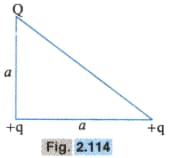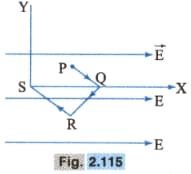HARD
12th West Bengal Board
IMPORTANT
Earn 100
A particle A has charge and particle has charge with each of them having the same mass . When allowed to fall from rest through the same electrical potential difference, the ratio of their speeds will become
50% studentsanswered this correctly
Important Questions on Interaction of Charged Particles, Electric Field and Potential
EASY
12th West Bengal Board
IMPORTANT
A cube of side has a charge at each of its vertices. The electric field due to the charge distribution at the centre of the cube will be -
EASY
12th West Bengal Board
IMPORTANT
In bringing an electron towards another electron, the electrostatic potential energy of the system
HARD
12th West Bengal Board
IMPORTANT
Identical charges are placed at each corner of a cube of side . Then the electrostatic potential energy of charge placed at the centre of the cube will be -
MEDIUM
12th West Bengal Board
IMPORTANT
The dimension of ( permittivity of free space, electric field) is
MEDIUM
12th West Bengal Board
IMPORTANT
Three charges and are placed at the vertices of a right angled isosceles triangle as shown in Fig. . The net electrostatic energy of the configuration is zero; if is equal to -

HARD
12th West Bengal Board
IMPORTANT
Two small spheres each having the charge are suspended by insulating threads of a length from a hook. The arrangement is taken in space, where there is no gravitational effect. Then the angle between the two suspensions and the tension in each will be
MEDIUM
12th West Bengal Board
IMPORTANT
Point charge moves from point to point along the path (as shown in figure, Fig. ) in a uniform electric field pointing co-parallel to the positive direction of -axis. The coordinates of the points and are and respectively. The work done by the field in the above process is given by the expression

HARD
12th West Bengal Board
IMPORTANT
A positively charged thin metal ring of radius is fixed in the place with its centre at the origin . A negatively charged particle is released from rest at the point where . Then the motion of is
